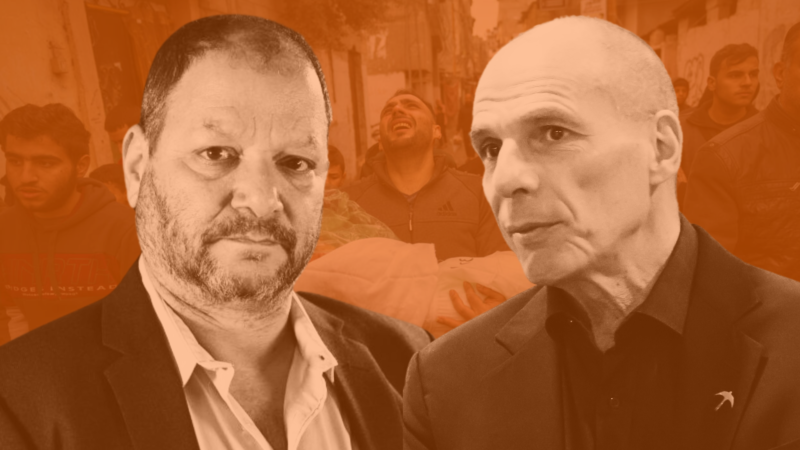In Northern Ireland, recent political shifts underscore the increasing momentum towards Irish reunification, particularly catalyzed by Brexit’s aftermath
In Northern Ireland, the 12th of July serves as a reminder of the still raw sectarian wounds of the recent past.
“The Twelfth”, as it’s known, is a protestant day of parades and marches. It celebrates the victory of King William of Orange over catholic King James II at the Battle of the Boyne in 1690. This ensured a protestant ascendancy in Ireland.
The night before, named the Eleventh Night, it is tradition for unionist communities to build huge bonfires, sometimes with effigies of republican politicians, and have street parties into the night.
I walk up towards a protestant community in north Belfast, but to get there I have to go through New Lodge, a working class catholic area.
“Is Tiger’s Bay that way?” I ask at a local newsagent.
“Yes, it is, but be careful, it’s rowdy tonight,” the man tells me. “Where are you from?”
“London,” I say.
“Ah, okay, you’ll be fine, then.”
Like most of Belfast it’s clear when I’ve crossed the unmarked lines dividing the communities still. In Tiger’s Bay, union jack flags flutter all around while pictures of King Charles III appear in windows.
Down Upper Canning St, I come to a large parking lot which has been converted into a party venue. Huge speakers pump out house music at an incredible volume. Teenagers stand around drinking spirit mixers and beers. The star of the show is the huge bonfire in front, not yet lit at 11pm. It has an Irish tricolour flag strapped across it.
I stand around with a beer for ten minutes before one of the kids asks: “What you doing here?”
“Just looking around,” I say.
“Don’t,” he says.
Brexit
The protestant festivities in July are a reminder of how real the divides in Northern Ireland still are. The Orange Order parade the next day brings out all the most extreme within the community. Many catholics don’t leave their houses—or leave the city completely.
But something historic is happening in this territory: the unionists are losing control. Locals say that even the parades have a more lacklustre feel in recent years.
In the 2019 general elections, Northern Ireland didn’t send a majority of unionist MPs back to London for the first time. Then in the May 2022 elections, Sinn Féin became the largest party in the Northern Ireland assembly, again for the first time, pushing the Democratic Unionist Party (DUP) into second place.
A year later, in May 2023, Sinn Féin became the biggest party in Northern Ireland local government, the first nationalist party to hold the most council seats.
On top of this, Sinn Féin, who’s flagship policy is a reunified Ireland, is leading in polls south of the border under the leadership of Mary Lou McDonald.
A 10 minute walk west up Duncairn Gardens from the bonfire and teenagers are the offices of John Finucane, one of the seven Sinn Féin MPs who were returned to Westminster at the 2019 general election.
For many in Northern Ireland, the big change that has accelerated the trend towards Irish reunification is the 2016 vote for Brexit.
“I think everybody would accept that since Brexit, the conversation around a unified Ireland has taken place at a pace which people have never seen before,” Finucane tells me.
“The elections in 2022 and 2023 demonstrate that people are looking more and more on the horizon towards Dublin rather than to Westminster, for all of the reasons that we have seen over the last six or seven years.”
He adds: “The chaos, the recklessness, that emanates from Westminster shows time and time again that they do not care about the interests of people here.”
Finucane and his fellow Sinn Féin MPs practise a policy of abstentionism, which means they do not physically take up their seats in the House of Commons. Their argument is that British political control over Northern Ireland is illegitimate and working within it formally endorses it.
Finucane’s father, Pat, was a prominent lawyer killed by loyalist paramilitaries from the Ulster Defence Association (UDA) in 1989 as he ate Sunday lunch with his family.
“It is for the people here to decide what their constitutional future will be. If the majority decide that they want to maintain the union with London, then that is what the outcome will be. If the majority instead want to have something different, they want to have a new Ireland. And I think more and more people, certainly outside of the Republican base, are having that conversation.”
Young progressives
Chris Hazzard, Sinn Féin MP for South Down since 2017, wants to meet at the James Connolly Centre in west Belfast. Connolly is a hero of the republican struggle as a key figure in the Easter Rising of 1916, after which he was shot dead by the British.
Hazzard won South Down for Sinn Féin 101 years after Connolly was killed. And he says that the prospects for Irish reunification have never been better.
“It’s the closest we’ve been since partition,” he says. “We’re not only picking up those republicans who maybe fell out of the electoral system, were maybe more hardline once, who now see the opportunities that now exist and are coming back to us.
“But equally on the other side of it, the more progressive minded younger people on the civic issues, things like abortion, marriage equality, who haven’t liked how the DUP have done things, and who despise Tory administration, that’s been a really big motivating factor.”
The historic nature of what is unfolding in Northern Ireland seems to be lost on many. The territory was designed to maintain a unionist majority. In the 1918 election, Sinn Féin won an overwhelming victory, with 85% of the seats.
But instead of allowing independence, the British government partitioned the island three years later, in 1921. The new territory was composed of six counties in the north, which had a clear protestant majority.
The resulting political entity was constructed with a lot of gerrymandering. There wasn’t one person, one vote. A business owner could have up to six votes and you had to own your own house. Very often catholics couldn’t vote. The state was essentially built to maintain protestant supremacy.
The plan was left in tatters in 2019 when Sinn Féin, led by Michelle O’Neill, won the most seats in Westminster.
Impasse
Sinn Féin’s recent electoral success was a test for the Good Friday Agreement, signed in 1998. The system had worked while the DUP were running the executive, but when that changed, there was a stalemate.
For nearly two years after becoming the largest party at Stormont, Sinn Féin was not allowed to form an executive, which required DUP approval.
“The Good Friday Agreement stipulates that the first minister should come from the largest party,” says Hazzard.
Before the resolution of the impasse in February, Hazzard told me: “I really can’t overstate the extent to which people are just so fed up with that approach from unionist political leaders. You can’t have it both ways. You were First Minister and now things are changing. You can’t just throw your toys out of the pram and say, ‘I’m not doing democracy anymore.’”
Hazzard believed there was a “real sense of frustration and annoyance”. “You go out in the street and ask 100 people, what do they really believe? And I’m pretty sure 99 of them are going to say they just don’t want to work under Michelle O’Neill. That would be the view.”
But the stalemate was helping the republican cause, Hazzard added. “People are saying if the system doesn’t work it’s time for something new.”
How far O’Neill is allowed to operate as First Minister still remains an open question.
Business community
Another interesting part of the dynamic unfolding is that the business community may be increasingly getting behind a united Ireland.
“The DUP would traditionally have had a fairly significant hold in what you would call the pro business type community,” Hazzard says. “Brexit smashed that into a million pieces.”
He continued: “I was chatting with a guy, a businessman this morning, actually, who comes from the unionist tradition. He was talking about the huge surpluses now that the Dublin government is running, and he was saying, ‘they’re a very wealthy country, part of the European Union’. He’s a businessman. He’s saying, ‘all my trade’s with the south’. Five years ago, he would not have been having that conversation.”
Danny Morrison, a former national director of publicity for Sinn Féin, added: “The business community, which traditionally was dominated by the unionists, now see the economic benefits from being in the European Union. So they’re going to go with the flow.”
Morrison, who was a spokesman for Bobby Sands, added: “A lot of unionists have been disillusioned by a number of factors, including how successive British governments have treated them.”
The DUP has reverted to the right and towards their base, which has opened up a large centre ground. The Alliance Party, which is described as a centre ground party, made huge advances similar to Sinn Féin. They have quickly become the third party in Northern Ireland.
“You have your Republican community who will always vote for our unity, you have your unionist community who will always vote for that,” added Hazzard. “But that centre ground is now going to be the defining place, and the politics of the last five to ten years is making them look one direction at the moment.”
Preparing for reunification
The prospect of a reunified Ireland has come on to the horizon quickly, largely since the Brexit vote, so thinking about what that might look like in practice is inchoate.
Anne Cadwallader is a British journalist who has lived in Belfast since the early 1980s. Until recently she worked at the Pat Finucane centre, named for John’s father.
“Sinn Féin are arguing constantly with the Irish government that they should start preparing for unity now, so that when it happens it isn’t a kind of huge shock to the system,” she says about a united Ireland.
“What would it look like? They say that if there is a united island, it wouldn’t just be the south with the north tacked onto it, it would have to be an entirely new state.”
There are many open questions and no side seems to have even started grappling with the realities.
“Would there have to be a new flag? Would there have to be a new national anthem? What would the health service look like? Who would control education?” asks Cadwallader.
“All those issues have to be looked at and thought over so that when people vote, they know what they’re voting for.”
The Good Friday Agreement enshrines the right to a referendum on reunification. But the process is amorphous.
As part of the Agreement, a provision for holding a reunification poll was made in UK law. The Northern Ireland Act 1998 states that the UK government will allow a vote “if at any time it appears likely to him that a majority of those voting would express a wish that Northern Ireland should cease to be part of the United Kingdom and form part of a united Ireland”.
But it is not clear exactly what would satisfy this requirement. It’s also unclear how many in the Republic of Ireland would support it.
The DUP did not respond to requests for an interview.
Matt Kennard is chief investigator at Declassified UK. He was a fellow and then director at the Centre for Investigative Journalism in London. Follow him on X @kennardmatt
Do you want to be informed of DiEM25's actions? Sign up here















